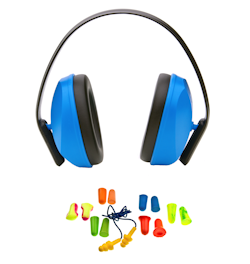Hearing Protection Devices (HPDs) - Basic Requirements
Hearing protection devices (HPDs) are considered the last option to control exposures to noise.
HPDs are generally used in conjunction with other hazard controls.
- Employers must make HPDs available to all employees exposed at or above the action level.
- Employers must ensure that HPDs are worn by employees as required by Table G-16 of 29 CFR 1910.95 or who are exposed at or above the action level and who:
- have not yet had a baseline audiogram established or
- have experienced a standard threshold shift (STS).
HPD Selection and Use

It is essential to the success of the program to have someone responsible for the selection of hearing protection devices and the supervision of their use. They must be able to evaluate and select appropriate devices for each employee, based on proper fit, the employee's noise exposure, hearing ability, communication needs, personal preferences, and other constraints imposed by job tasks or work environment.
- Earplugs come in a variety of sizes, shapes, and materials and can be reusable and/or disposable. Earplugs are designed to occlude the ear canal when worn.
- Earmuffs are another type of hearing protector. They are designed to cover the external ear and thus reduce the amount of sound reaching the inner ear. Care must be taken to ensure that the seal of the earmuff is not broken by safety glasses, facial hair, respirators, or other equipment, as even a very small leak in the seal can destroy the effectiveness of the earmuff.
- Hearing bands are a third type of HPD and are similar to earplugs, but with a stiff band that connects the portions that insert into a worker's ears. Hearing bands may not provide the same noise attenuation as properly fitting earplugs, as the portions that fit into the ears are stationary and cannot be twisted into place like earplugs.
Earplugs, earmuffs, or hearing bands alone might not provide sufficient protection from significantly high noise levels. In this case, workers should wear double hearing protection-earmuffs with earplugs. Avoid corded earplugs, as the cord would interfere with the muff seal. Additionally, hearing bands cannot be worn with earplugs or earmuffs, as the connected band would interfere with the muff seal, and there is no room to insert earplugs at the same time.
Knowledge Check Choose the best answer for the question.
2-5. What should you do if your earplugs can't provide adequate reduction in noise levels?
You forgot to answer the question!
